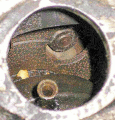
Clutch & Gearbox
The gearbox appears to be OK but the clutch was seized solid after standing for 25 years
March 2004:

After the gearbox inspection cover was removed, the clutch bell housing looked like this:

View of the clutch release bearing oiler. This is the early type with clutch material rivetted to the flywheel and pressure plate. See parts drawing below.

The gearbox was just drained and refilled with SAE40 engine oil.
Later - as the gearbox was sluggish with poor synchro when cold, I filled it with Castrol 10W/60 fully synthetic, the same as used in the engine. Result - good sychro on all gears from cold; a remarkable improvement.
April 2004:

Despite having stood in damp conditions for over 25 years, the clutch freed off with very little persuasion. However there is some clutch spin until a gear is engaged (noisy!)
A very short test run showed that the clutch and all four gears worked well, the brakes less so.
June 2004:

The clutch pressure spring inside the clutch housing; I don't know what that is shining? - white paint maybe?
August 2004:

Fibreglass gearbox cover from Available Austins (see Parts Suppliers) was a fair fit but needed some fitting. Long 2BA screws into original threaded holes in gearbox cover plate hold it at the front.
a new rubber gearbox cover is now fitted (see New Cover)

Access to the gearbox filler and the clutch release bearing oiler unfortunately means taking this cover off.

. . . . . and the fitted item, with a close-up of the superb grommet from the Vintage Supplies range (see Parts Suppliers)
September 2004:

The dragging clutch was a nuisance when trying to engage a gear when stationary. The old trick of touching one of the synchro gears before engaging first didn't work.
The covers were removed and the clutch operation watched through the inspection hole. The problem appears to have been the centre plate sticking on the splines (even after oiling), probably due to rust on the exposed part of the first motion shaft.

Picture shows through the inspection hole: foreground: the clutch bearing release oiler (GP6); at the top is the outer rim of the clutch cover (GP19), just above centre is one of the six holes in the driven steel clutch plate centre (GP25).
This plate is quite thick and through the hole can be seen one of the flywheel mounting nuts. The pressure plate (GP22) cannot be seen in this view.

Oiling the splines of the clutch plate centre (GP25) had no effect so a little more cunning was applied. First the clutch pedal was fully depressed; the centre plate was prodded with a long screwdriver until it came "unstuck" from the flywheel. When it came free it was very free suggesting that the problem was caused by binding on the splines when the plate was fully forward.

It was slid the very short distance back and forwards over its splines (the centre clutch plate itself is springy and gives a little to permit a small amount of overtravel). I filed a slot in the end of a prybar (small crowbar) to fit over the webs of the centre plate so I could slide the plate back and forth with some vigour. A noticeable improvement in the ease of movement was noted after about 10 minutes of vigorous pulling and pushing!
With the engine running, I can now depress the clutch pedal and watch the centre plate (and with it the gearbox primary shaft) stop rotating. Clutch spin eliminated 100%. It is now so good that I sometimes have to partly release the pedal to rotate the gearbox to engage a gear!
April 2005:

and to finish it off, new clutch & brake pedal rubbers from ATDC Spares (see Parts Suppliers)
April 2006:
It occasionally jumps out of bottom gear; usually on a long hill where you really need bottom gear! Checking up in Newnes vol 4 page 425 shows that "the gear most likely to cause trouble is the first speed gear" - due to the locking ball not holding the selector firmly in position.
Later models (1936-on) had a modified selector shaft but one dodge is to rotate the 1st gear selector shaft so the ball slides into an unworn part of the locking groove. This can be done without any dismantling.

So as the clutch bearing needed oiling, whilst the gearbox cover was off, I took off the gearbox top cover.

The gasket fell apart so a new one was tapped out - years since I have done this and very satisfying!
December 2006:
yes, bottom gear definitely stays in better - and the gearbox is overall much quieter and smoother after 2,000 miles on fully synthetic oil (Castrol RS 10W/60, the same as I use in the engine)


